Up Next
Artist Sin Wai Kin on the Power of Transformation
We spoke with Sin Wai Kin for "Up Next," our series spotlighting art world talents on the verge of superstardom.
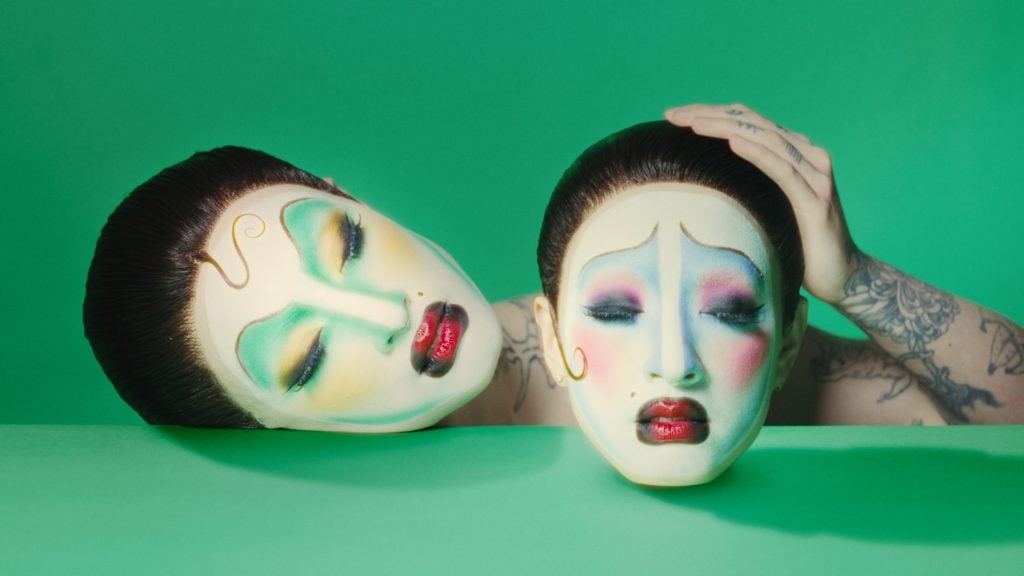
“Storytelling not only represents but creates reality,” said artist Sin Wai Kin on a video call from their London studio late last fall. The Toronto-born artist had recently opened “Portraits” at Soft Opening’s Minerva Street gallery, an exhibition of five moving-image film portraits of characters inspired by Cantonese and Peking Opera—The Universe, Change, Wai King (masculinity), The Construct (good and evil) and The Storyteller (the exhibition closed in December 2023).
Playing on screens displayed throughout the gallery—and set against floor-to-ceiling white velvet curtains—the characters occupied nearly life-size dimensions. In keeping with the artist’s decade-long practice, Sin appeared in all of these guises, transforming their appearance with elaborate make-up, costuming, and staging (the artist works with a team, often including a makeup artist, to create these works). The artist has, over the past decade, emerged as a singular creative force in the art world, with narrative films and performances that center on a revolving cast of archetypal characters and mix together drag aesthetics, classical theater, and science fiction.
“My characters exist in multiple lives, emerging in different projects, in relationship to each other to put different ideas or concepts in relationship to each other. Together, they create a series of interacting relationships,” they said. For Sin, the characters have become a vehicle for imagining new, and fantastical, ways of living. “Each of the characters is a kind of embodied speculative fiction, a way to think through issues I’m grappling with. We embody narratives and these characters offer alternative storylines than what we are familiar with” Sin said. “As a transgender person, I’m always trying to find myself in the binary of masculinity and femininity.”
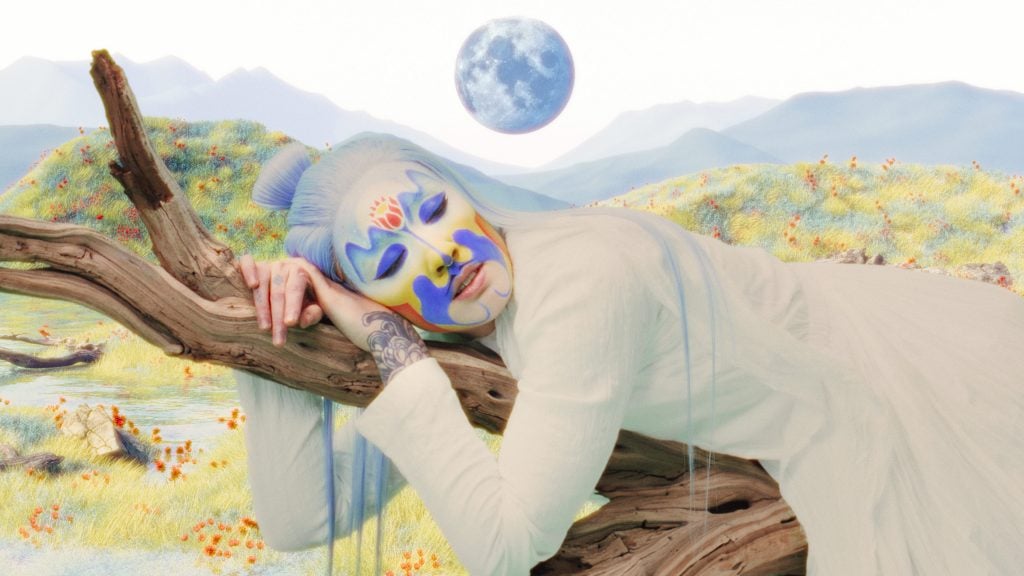
Sin Wai Kin, The Universe (film still) (2023). Single-channel video, 4K, color © the artist Courtesy the artist and Soft Opening, London.
In the early 2010s, Sin (who relocated to London from Toronto after high school) became familiar with female drag performers such as Holestar and Amanda Lepore. Considering the possibilities of drag as a queer lens for femininity, in 2013, Sin began to perform as their first character, Victoria Sin, in clubs throughout London. Victoria Sin, with big platinum blonde hair and an over-the-top hourglass figure, was an exaggerated stage persona, a caricature of the voluptuous sexuality of Hollywood’s leading ladies—but with an acerbic, winking lilt. Performing a series of decidedly “feminine” actions, Victoria Sin’s character teetered on parody—while pointing back to the often unreasonable and oppressive expectations expected of women by society.
Over the years, Sin developed other characters who added new dimensions to their films and performances. Working within the intersection of gender, technology, and speculative fiction, the artist is defining a meaningful, new visual language for the ways history is told and imagined. Such interdisciplinary projects have earned them critical and institutional support. In 2022, the artist was shortlisted for the Turner Prize and their works have been shown in institutions including Tai Kwun Contemporary, Hong Kong (2023), the Solomon R. Guggenheim Museum, New York (2022); The British Museum, London (2022); Palais de Tokyo, Paris (2019); and Tate Modern, London (2017). This year, the artist will participate in a flurry of exhibitions. Currently, the artist is the subject of exhibitions at Mudam (Luxembourg City, Luxembourg) and the Buffalo AKG Art Museum (Buffalo, NY), and has upcoming exhibitions at Cement Fondu (Sydney, Australia) and Accelerator (Stockholm, Sweden), among others.
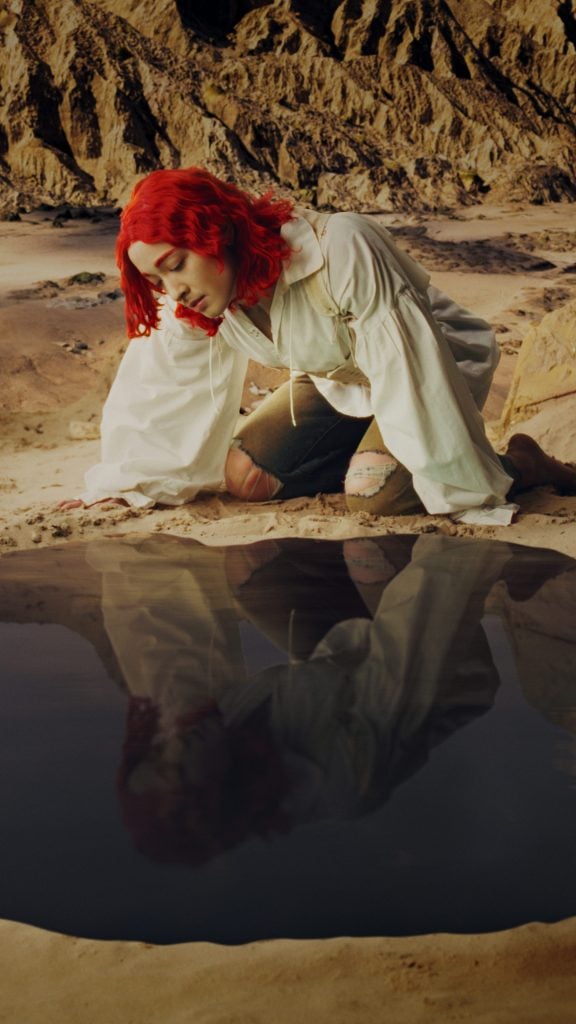
Sin Wai Kin, Wai King (film still) (2023). Single-channel video, 4K, colour © the artist Courtesy the artist and Soft Opening, London.
For Sin, the Soft Opening show was a moment to reflect on their oeuvre to date. “This project was a chance to sit still with my characters,” they said. “In making these works I was thinking a lot about image production. Images can tell stories.”
Storytelling, and how stories shape our realities, fascinates Sin. Science fiction books, in particular, have shaped the way they create their works. “Authors like Octavia Butler and Ursula K. Le Guin use science fiction not only to create a sense of escapism from the current social order and sociopolitical kind of context, but also to imagine how the world could be if it were different—not only what the possibilities are and what the ‘what-ifs’ are, but what it would feel to live in those worlds. I think that imagination gives people—gave me definitely—a perspective to look back on my everyday life with and see things differently,” Sin reflected.
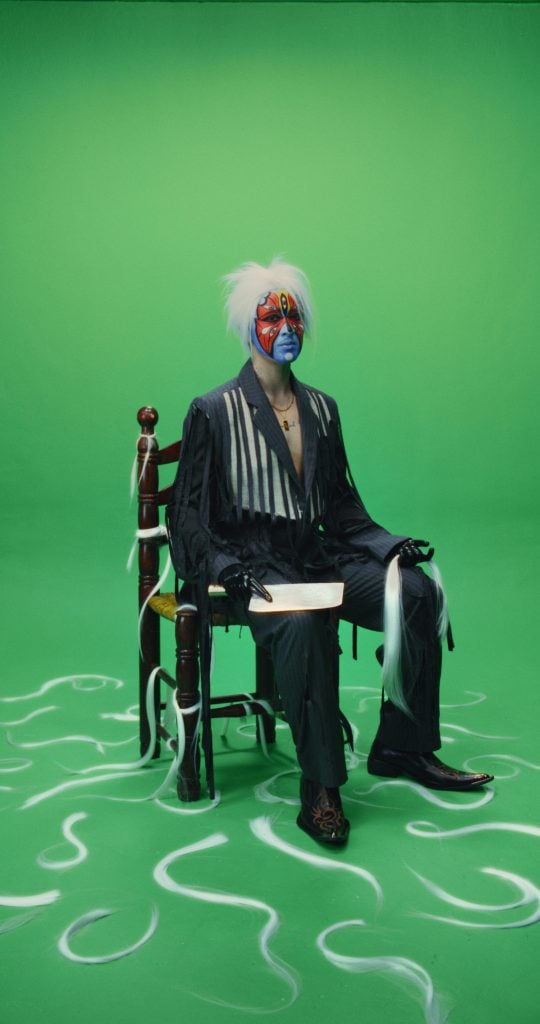
Sin Wai Kin, Change (film still) (2023). Courtesy of the artist and Soft Opening, London.
In these works, Sin grapples with ways to engage narrative through nearly still imagery. Each of the works in “Portraits” references a famous art work from history. The Construct, for instance, is a play on Man Ray’s famous photograph Kiki with African Mask (1926), which pictures Kiki de Montparnasse resting her head alongside an African mask. “The Construct is a character that I usually present as two different people together, facing each other in order to think about a binary of good and evil or victim and villain in the context of femininity,” said Sin. “Here, with Man Ray’s image of the mask, there is the question of the exotic other. This tension might make us wonder how we may unwittingly be the villain in another person’s narrative.”
Other works reference Caravaggio’s Narcissus (1597–1599), Frida Kahlo’s Self-Portrait with Cropped Hair (1940); and Lu Zhi’s Chuang Tzu Dreaming of a Butterfly (Ming Dynasty). The portrait Storyteller, which pictures a newscaster at their desk, is an reinterpretation of the Mona Lisa.
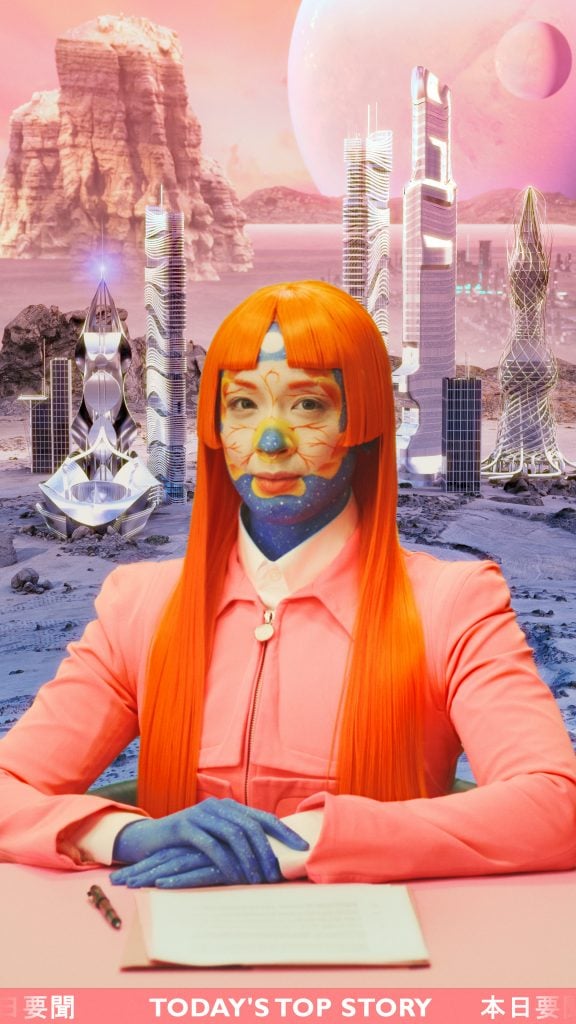
Sin Wai Kin, The Storyteller (film still) (2023). Single-channel video, 4K, color © the artist Courtesy the artist and Soft Opening, London.
“There’s controversy that the Mona Lisa might be a man dressed as a woman. It’s part of the ambiguity that surrounds her. I wanted to think about the character of a storyteller and ask questions of the storyteller’s intent or the importance of a storyteller’s intent,” Sin said. “Here the storyteller appears as a news presenter. A news presenter is a modern storyteller. It’s someone who is given license to tell something as the truth. But the reality is everybody has an individual idea or experience of truth and these stories are manipulated or have motivations behind them.”
For Sin, positioning these characters within art historical imagery is a way to open up the images to fresh interpretation, and to allow for a reconsideration of our histories more broadly. Ultimately, though, all of these works are rooted in intimate realities.
“In the end, we can call these self-portraits. I’m every character. I’m performing every character, but even in the conception of each character—while I am thinking about universal themes—it all emerges from extremely personal experiences,” said Sin, “From these individual experiences, we can discover moments of transformation. The more personal the work is, the more it becomes universal.”





